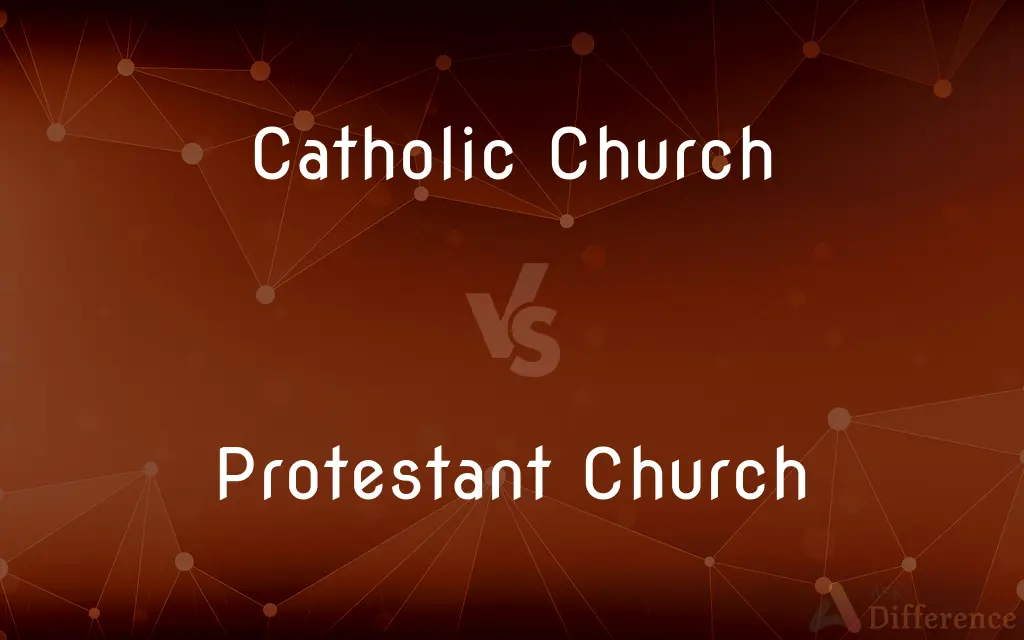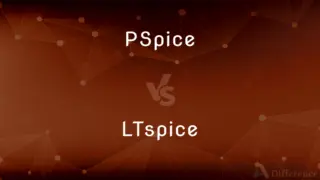Catholic Church vs. Protestant Church — What's the Difference?
Edited by Tayyaba Rehman — By Fiza Rafique — Published on January 4, 2024
The Catholic Church is the largest Christian church, led by the Pope, with traditions like transubstantiation. Protestant churches emerged in opposition to certain Catholic teachings, emphasizing Bible primacy and diverse doctrines.

Difference Between Catholic Church and Protestant Church
Table of Contents
ADVERTISEMENT
Key Differences
The Catholic Church and Protestant Church are both Christian denominations, but they have different origins and beliefs. The Catholic Church, established in the 1st century AD, is the largest Christian denomination and is centered in the Vatican, led by the Pope. The Protestant Church, on the other hand, originated in the 16th century during the Reformation when Martin Luther and others protested against certain practices and teachings of the Catholic Church.
The Catholic Church upholds traditions such as transubstantiation, which is the belief that during the Eucharist, the bread and wine become the actual body and blood of Christ. The Protestant Church, in contrast, generally views the Eucharist as symbolic.
The Catholic Church and Protestant Church also have different views on church authority. While the Catholic Church believes in the infallibility of the Pope when speaking ex cathedra, the Protestant Church typically rejects any single human authority, emphasizing the primacy of the Bible.
Sacraments are another area of difference between the Catholic Church and Protestant Church. The Catholic Church recognizes seven sacraments, including baptism, Eucharist, and confirmation. The Protestant Church, depending on the denomination, may recognize only two sacraments: baptism and the Lord's Supper.
Lastly, the Catholic Church and Protestant Church have different structures. The Catholic Church is hierarchical with the Pope at the top, followed by cardinals, bishops, priests, and deacons. The Protestant Church's structure varies by denomination, but many are organized congregationally, where local churches operate independently.
ADVERTISEMENT
Comparison Chart
Origin
Established in the 1st century AD.
Originated during the 16th-century Reformation.
Authority
Recognizes the Pope's authority and infallibility.
Emphasizes the primacy of the Bible.
Eucharist
Believes in transubstantiation.
Generally views the Eucharist as symbolic.
Sacraments
Recognizes seven sacraments.
Typically recognizes two: baptism and Lord's Supper.
Structure
Hierarchical, led by the Pope.
Varies by denomination; many are congregationally organized.
Compare with Definitions
Catholic Church
The Catholic Church's teachings emphasize tradition and the Magisterium alongside Scripture.
The Catholic Church relies on both the Bible and church traditions for guidance.
Protestant Church
The Protestant Church typically emphasizes the primacy of Scripture in teachings and beliefs.
Sola Scriptura, or Scripture alone, is a key tenet of the Protestant Church.
Catholic Church
The Catholic Church follows a hierarchical structure with the Pope at the top.
The Pope leads the Catholic Church as its highest authority.
Protestant Church
The Protestant Church emerged during the Reformation in opposition to certain Catholic teachings.
The Protestant Church began when Martin Luther posted his Ninety-Five Theses.
Catholic Church
The Catholic Church upholds the tradition of seven sacraments.
Confirmation is one of the seven sacraments in the Catholic Church.
Protestant Church
The Protestant Church encompasses various denominations with diverse practices and beliefs.
The Baptist and Lutheran churches are both part of the Protestant Church but have distinct practices.
Catholic Church
The Catholic Church is the world's largest Christian denomination.
The Catholic Church has its headquarters in the Vatican.
Protestant Church
The Protestant Church generally recognizes two main sacraments: baptism and the Lord's Supper.
In the Protestant Church, the Eucharist is often seen as symbolic rather than transubstantial.
Catholic Church
The Catholic Church believes in the infallibility of the Pope when speaking ex cathedra.
When discussing dogmas, the Catholic Church might reference the Pope's infallibility.
Protestant Church
The Protestant Church varies in structure across denominations, often congregationally organized.
Unlike the centralized Catholic Church, the Protestant Church's structure can vary widely.
Common Curiosities
Does the Catholic Church have more sacraments than the Protestant Church?
Yes, the Catholic Church recognizes seven sacraments, while the Protestant Church typically recognizes two.
What is the stance of the Catholic Church on the Eucharist?
The Catholic Church believes in transubstantiation, meaning the bread and wine become the actual body and blood of Christ during the Eucharist.
What is the primary governing body of the Catholic Church?
The primary governing body of the Catholic Church is the Vatican, led by the Pope.
How does the Protestant Church view the Eucharist?
The Protestant Church generally views the Eucharist as symbolic, not as the actual body and blood of Christ.
Who is the leader of the Catholic Church?
The Pope is the leader of the Catholic Church.
How do teachings vary between the Catholic Church and Protestant Church?
While both are Christian, the Catholic Church emphasizes tradition and the Magisterium alongside Scripture, whereas the Protestant Church emphasizes the primacy of the Bible.
Are there many denominations within the Protestant Church?
Yes, the Protestant Church encompasses various denominations with diverse practices and beliefs.
What is the Catholic Church's stance on the Pope's infallibility?
The Catholic Church believes in the infallibility of the Pope when speaking ex cathedra on matters of faith and morals.
Where is the headquarters of the Catholic Church?
The headquarters of the Catholic Church is in the Vatican.
How did the Protestant Church originate?
The Protestant Church originated during the 16th-century Reformation in opposition to certain teachings of the Catholic Church.
Is the Anglican Church part of the Catholic Church or Protestant Church?
The Anglican Church is part of the Protestant Church, though it shares some similarities with the Catholic Church.
What role does Mary play in the Catholic Church compared to the Protestant Church?
Mary holds a more prominent role in Catholic theology, revered as the Mother of God, while in most Protestant denominations, she's respected as the mother of Jesus but not venerated to the same extent.
Which church believes in Sola Scriptura?
Sola Scriptura, or "Scripture alone", is a key tenet of the Protestant Church.
How is the structure of the Protestant Church typically organized?
The structure of the Protestant Church varies by denomination, but many are organized congregationally.
Are the Bible versions different between the Catholic Church and Protestant Church?
Yes, the Catholic Bible includes several books not found in Protestant Bibles, referred to as the "Deuterocanonical" books or "Apocrypha".
Share Your Discovery

Previous Comparison
Migrant vs. Immigrant
Next Comparison
PSpice vs. LTspiceAuthor Spotlight
Written by
Fiza RafiqueFiza Rafique is a skilled content writer at AskDifference.com, where she meticulously refines and enhances written pieces. Drawing from her vast editorial expertise, Fiza ensures clarity, accuracy, and precision in every article. Passionate about language, she continually seeks to elevate the quality of content for readers worldwide.
Edited by
Tayyaba RehmanTayyaba Rehman is a distinguished writer, currently serving as a primary contributor to askdifference.com. As a researcher in semantics and etymology, Tayyaba's passion for the complexity of languages and their distinctions has found a perfect home on the platform. Tayyaba delves into the intricacies of language, distinguishing between commonly confused words and phrases, thereby providing clarity for readers worldwide.
















































